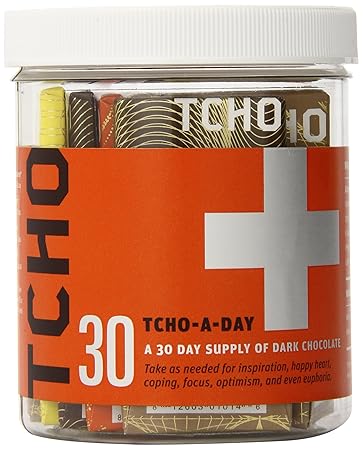
When it comes to chocolate, I used to belong to the cult of high cocoa percentage. My favorite was 70 percent, with a dash of 82.5 percent thrown in once in a while. The more I learned about chocolate, though, the more I realized that percentage has nothing to do with quality: I’ve had crummy 85 percent bars and fantastic 40 percent bars.
That’s because cocoa percentage means the percentage of the bar that comes straight from cocoa beans. Take my beloved 70 percent bar as an example: Seventy percent of that bar consists of refined cocoa beans, and 30 percent consists of all the other ingredients, like sugar, vanilla, sea salt, Pop Rocks, you name it.
TCHO Chocolate Tcho-a-Day Tub, $33 on Amazon
A one-month supply of quality chocolate to tempt you (or keep you satisfied, depending on how you look at it).
Just because you’ve tasted one 70 percent bar, though, doesn’t mean you’ve tasted them all. Each one has a unique mouthfeel and unique tastes going on. (Some genius came up with the fancy-sounding “mouthfeel” to describe how things feel in your mouth. Practically, this means whether it’s grainy or smooth, melts quickly or slowly, and so on.) One reason for this is that one chocolate bar might have significantly more cocoa butter in it than another. Both cocoa mass (aka cocoa powder) and cocoa butter are included in that 70 percent total.

Chowhound
As I write in my book, “Bean-to-Bar Chocolate: America’s Craft Chocolate Revolution,” “One 70 percent bar could include 50 percent cocoa solids and 20 percent cocoa butter; another could include 30 percent cocoa solids and 40 percent cocoa butter (that would create a very smooth, buttery bar!). To make it even more complicated, different types of beans naturally contain different amounts of cocoa butter. Some are more lean, others more fatty. A bean’s natural ‘butteriness’ will change the consistency of the resulting chocolate.”
Bean-to-Bar Chocolate: America’s Craft Chocolate Revolution
A book to savor (alongside something sweet, ideally).
Milk chocolate is generally a pretty low percentage, usually around 40 percent or below (Hershey’s is 11 percent). I’m in love with Zotter’s 40 percent bar made with “organic Tyrolean mountain milk” as well as Fran’s smoked salt thins.
Dark chocolate doesn’t have a legal definition in the U.S. (it’s under the umbrella of semisweet or bittersweet chocolate). It’s usually at least 55 percent, but most dark chocolate lovers enjoy 70 percent or above. I’m obsessed with a new type called dark milk chocolate, a high-percentage milk chocolate that’s the best of both worlds: You get the intense flavors of dark chocolate with the creaminess of milk chocolate. My favorite right now? Chocolate Naïve’s 62 percent dark milk with porcini. (Yes, you read that right: mushrooms!)
Then there are some dark chocolate bars that clock in at 100 percent. That means they include only ground-and-refined cocoa beans, and the trick for the chocolate makers is bringing out the natural flavors of those beans to make them not only edible but also enjoyable. The best ones—like those from Fruition and Pralus—are a far cry from baking chocolate. I challenge you to taste a 100 percent bar for Valentine’s Day: You might just find your true love.
Related Video: How to Make Triple Chocolate Coffee Cake
All featured products are curated independently by our editors. When you buy something through our retail links, we may receive a commission. For more great hand-picked products, check out the Chowhound Shop.
from Food News – Chowhound http://bit.ly/2MF6tOT
via IFTTT



No comments:
Post a Comment